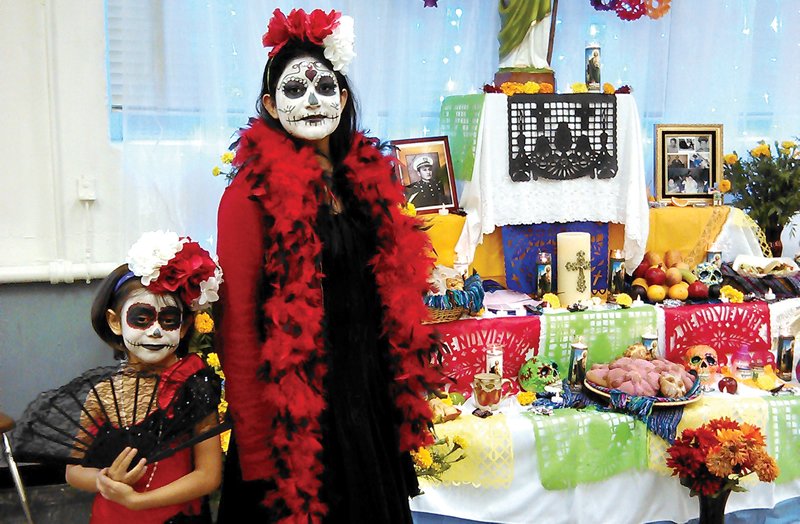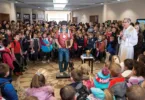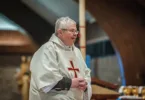
Mexican artist José Guadalupe Posada is responsible for the familiar “La Catrina” figures (portrayed here by sisters Jocelyn and Naomi Ubanda) often associated with the holiday, and his striking image is still part of modern Day of the Dead observances.
by Libby Hyde
libby.hyde.theleaven@gmail.com
KANSAS CITY, Kan. — If the nearest Catholic cemetery seems a bit “lively” this month compared to its non-Catholic counterpart, there is a reason.
November is the month of the dead.
You can see Catholics visiting the graves of their deceased relatives, often tidying them up and leaving little memorials of flowers, sacramentals and other items.
This is one of those “Catholic things” that many Protestants and secular-minded Americans tend to misunderstand — thinking it’s some sort of weird, macabre celebration of death.
Far from it. Rather, this is a celebration of life.
In November, Catholics celebrate the life of their beloved deceased — both their earthly life and their eternal life. The month starts off with the solemnity of All Saints on Nov. 1 and is followed by All Souls’ Day on Nov. 2, when we pray for all the faithful departed.
Praying for those souls undergoing their final sanctification in purgatory is a work of mercy, according the Catechism of the Catholic Church (1031). But it is also a time of sacred remembrance.
Catholic customs regarding All Saints and All Souls vary from culture to culture. Just as the eve of All Saints’ Day — All Hallows’ Eve — became popularized as Halloween in the American tradition, in Mexico, the Dia de los Fieles Difuntos — or Day of the Dead — celebrated on Nov. 2 is a festive, family- oriented occasion.
On Nov. 1, Blessed Sacrament Parish in Kansas City, Kansas, did its part to mark the important day.
Some 55 children in the parish’s religious education program, and 40 parents, were divided into groups and worked on constructing one of six altars, which were open for public viewing that evening and the morning of the next day.
Dia de los Fieles Difuntos is an important celebration in Mexico, explained Lucy Bernal, parish director of religious education. And, as director of both the parish’s family catechesis program and the confirmation class, she saw it as the perfect opportunity to bring families together to work on the ultimate family project.
As in the United States, the first day of November in Mexico is a time when families visit the gravesites of their deceased relatives and offer prayers for them.
What is unique to the Mexican tradition, said Bernal, is that family members also create altars to honor their deceased.
Such altars, often colorful and elaborate, feature traditional elements such as flowers and candles, and statues of favorite saints. They also features less traditional items like Coca-Cola and chocolate — whatever the deceased enjoyed drinking or eating in life.
In this instance, construction of the altars was done in conjunction with the parish’s first Communion, confirmation and family catechesis classes.
“The reason we are doing this is to tell the people that [the day is] not just something that is sad,” said Bernal. “It is a time to be in prayer and offer the Mass on Nov. 2 for those loved ones.”
But it also offers parishioners the practice of a familiar devotion in their new setting.
“Sometimes when [parishioners] come from another country, they can’t go back to the country they came from, so they don’t get to enjoy that tradition,” she continued. “This is something that the church really supports because we are all supposed to come together to remember [the deceased] in prayer.”
Pastor Father Mark Mertes was interested in starting the tradition at Blessed Sacrament for exactly that reason,
“It is a good way for the parishioners who have origins in Mexico to reconnect with their country,” he said.
“It’s also a great way to connect other traditions with our Catholic faith, which is universal,” he added.
Ilse Torres, a confirmation candidate at Blessed Sacrament, offered up part of the confirmation group’s altar in memory of her recently deceased uncle.
“My family doesn’t really celebrate Dia de los Muertos,” said Torres, “so this is my first time.
“But it is so beautiful — and it was exciting to make this project special to each and every person.”
Altars seen at Blessed Sacrament incorporated many traditional aspects from the celebration of Dia de los Fieles Difuntos in Mexico. According to Bernal, some altars feature several levels with each one representing something different.
For example, the highest level is closest to God. Therefore, pictures or relics of saints, Jesus or the Blessed Virgin Mary may be put on that level because they are closest to God. The food and treats, on the other hand — the things the person would have enjoyed during their life — are displayed on a lower level.
Father Mertes and Bernal agree that it is important to know this day is about remembering the deceased in a positive way because it is supposed to be a celebration of their life.
“We recognize that we are called to pray for those who have died,” Bernal said. “As part of the tradition of Dia de Los Muertos, we keep praying for their souls.”
Xochilt Carbajal, a parishioner at Blessed Sacrament, used to celebrate Dia de los Muertos with her family in Mexico. Now that she lives in the United States, she wants to continue and pass on the tradition.
“This celebration directly connects to our Catholic faith because we remember the dead through this celebration,” she said. “It was passed on to us that the souls of the departed are always with us, and this is a belief we want to pass on.”






